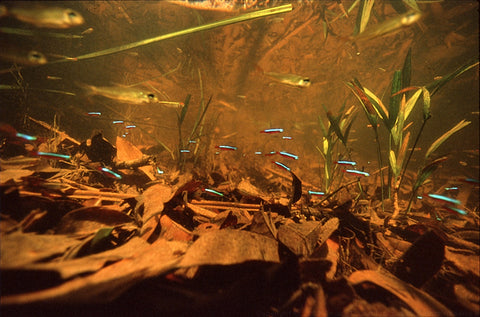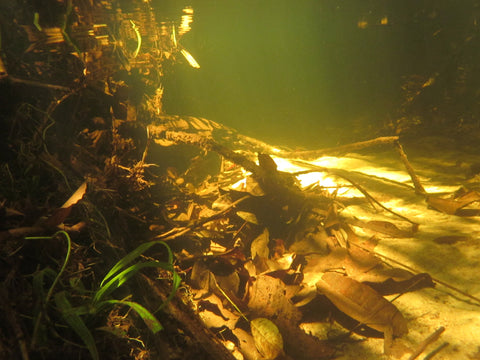- Continue Shopping
- Your Cart is Empty
Leaves in the long term...Should the stay or should they go?
How is your "New Botanical" style aquarium progressing?
Well, I hope!
By now, you've probably realized that this type of aquarium is quite different from ones that you've managed in the past, both from a functional and aesthetic standpoint.
After a few weeks, you start noticing a few things happening in your aquarium that weren't before. Primarily, your leaves, which you no doubt careful arranged on the bottom of your tank, are starting to look a bit, well, "weathered"- kind of curled up,their color is darkening; they're just generally starting to break down a bit.
Do you take them out? Leave them in? What, exactly is going on?
If you have some idea of what happens to leaves and other botanical materials in nature after a period of time underwater, you'll be able better informed to determine what, if any course of action you wish to take. Let's take a quick look at what happens in nature.
After a leaf is shed from a tree and has entered the aquatic environment, it is subject to physical abrasion, microbial degradation and invertebrate fragmentation. Initially, the leaves are colonized by bacteria and fungi. As these populations grow, the leaves may begin to physically get smaller, both from their activity, and from the physical actions of water flow/breakup from fish activity. This is what we call "decomposition."

Simply put, decomposition is the initial stage in the recycling of nutrients that have been used by an organism (in this case, a tree) to build its structure, and are returned to the ecosystem upon its death. It is the process in which the dead tissues break down and are converted into more simple organic forms (phosphorous, tannin, lignin, etc.) that are utilized as the food source for many of the species at the literal "bottom" of the aquatic ecosystem. (Detritivores)
The rate of physical breakdown of the leaves is highly variable. Some tree leaves contain proportionately large amounts of tougher structural compounds (lignin and cellulose, typically) which render them difficult for microorganisms to break down, and less likely to be consumed by grazing or detritivorous fishes as well. In general, leaves physically break down over time when submerged, and function as habitat and/or substrate for invertebrates and microorganisms. It's also a source of dissolved nutrients that are utilized by aquatic communities.
In the aquarium, similar processes occur. However, being a closed system, and aquarium requires management from us aquarists in order to function properly in the long term. Having significant quantities of decomposing leaves in an aquarium can affect pH, nitrate levels, and dissolved oxygen. In a well managed system, which has proper filtration, incorporates regular water exchanges, and is not overcrowded, the affect of this "leaf litter" is positive, from both an aesthetic and environmental standpoint.

However, in a system that is subject to, shall we say, more "relaxed" husbandry, the affects of decomposing leaf litter and botanicals can ultimately prove to be more challenging to stability.
A system with leaf litter and botanicals is not "set and forget." It requires regular maintenance and care, like any other aquarium. Unlike a more "sterile" system that we are accustomed to, a system containing quantities of leaf litter and botanicals will accumulate fungi, biofilms, and some algae, adding to the richness of the aquatic environment. In short, it's what we'd definitely call a "dynamic" system!

If you're conducing regular water exchanges, removing some of the accumulations of detritus and debris in the process, and providing reasonable water movement within the confines of your aquarium, then that is what I'd call "well-managed", and you shouldn't have many problems.
Yes, your water will accrue a "tint" caused by the humic/tannic acids, and the pH may be influenced somewhat (more significantly in softer water). However, the overall water quality in a well-maintained system with these components should be high. I personally have not noticed significant differences in nitrate accumulation, for example, between well-managed systems containing quantities of leaf litter, and those which don't.

So, to get to the main point of this discussion one again...Do you remove the leaves as they break down in your aquarium, or leave them in? I think it all boils down to water quality. If you regularly monitor pH and nitrate, for example, you'll be able to spot any trends over the short to medium term. If there is a correlation between accumulating nitrate, decreasing pH, and other annoyances, such as excessive nuisance algae, etc., then you should probably remove some of the decomposing biomass and replace it with fresh material.
On the other hand, if you are not noticing any detrimental environmental effects by leaving the decomposing leaf material in your tank, and if the aesthetics don't bother you, there is no harm in leaving it in your aquarium, and simply replacing the decomposing leaves with freshly prepared ones. We freely acknowledge that the aesthetics of these types of aquarium are NOT for everyone!

In summary, you need to "manage" a "New Botanical" style aquarium. It accepts the occurrence of dynamic natural processes that can affect the closed environment of an aquarium, and you simply need to monitor the system, as you would any other. It's no more difficult than a planted aquarium, reef system, or African Cichlid aquarium. More than anything else, observation, patience, and a good deal of intuition are just as important as the water testing which you should be performing on a regular basis in any aquatic system.

Enjoy, question, and discuss what you've learned about managing this type of aquarium with fellow hobbyists. There is a lot to learn about the dynamics of such systems, and by having a basic understanding of the processes which occur in them, you are in a unique position to add to the body of knowledge about this fascinating underwater environment!
Stay engaged. Stay fascinated. Stay on top of things.
And stay wet.
Scott Fellman
Tannin Aquatics












Scott Fellman
Author